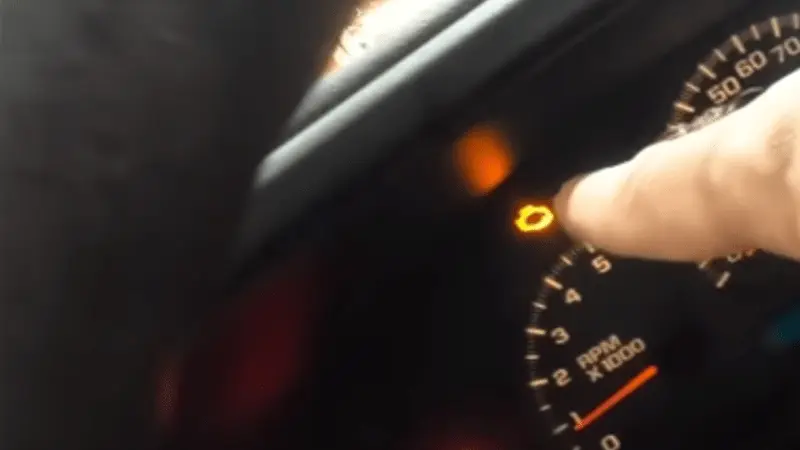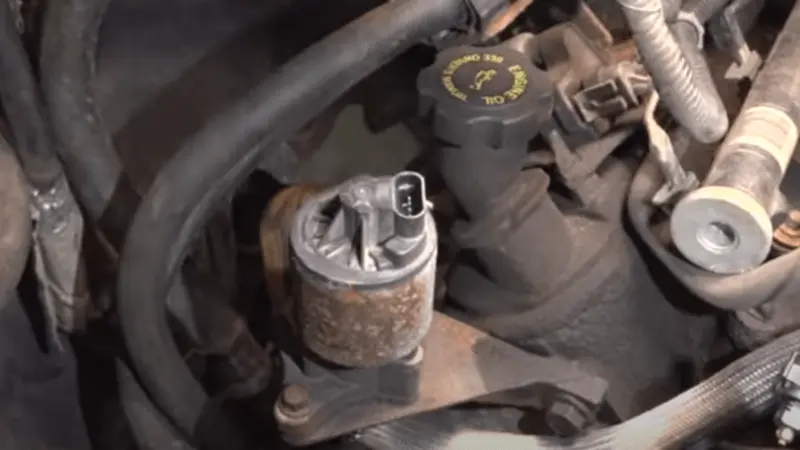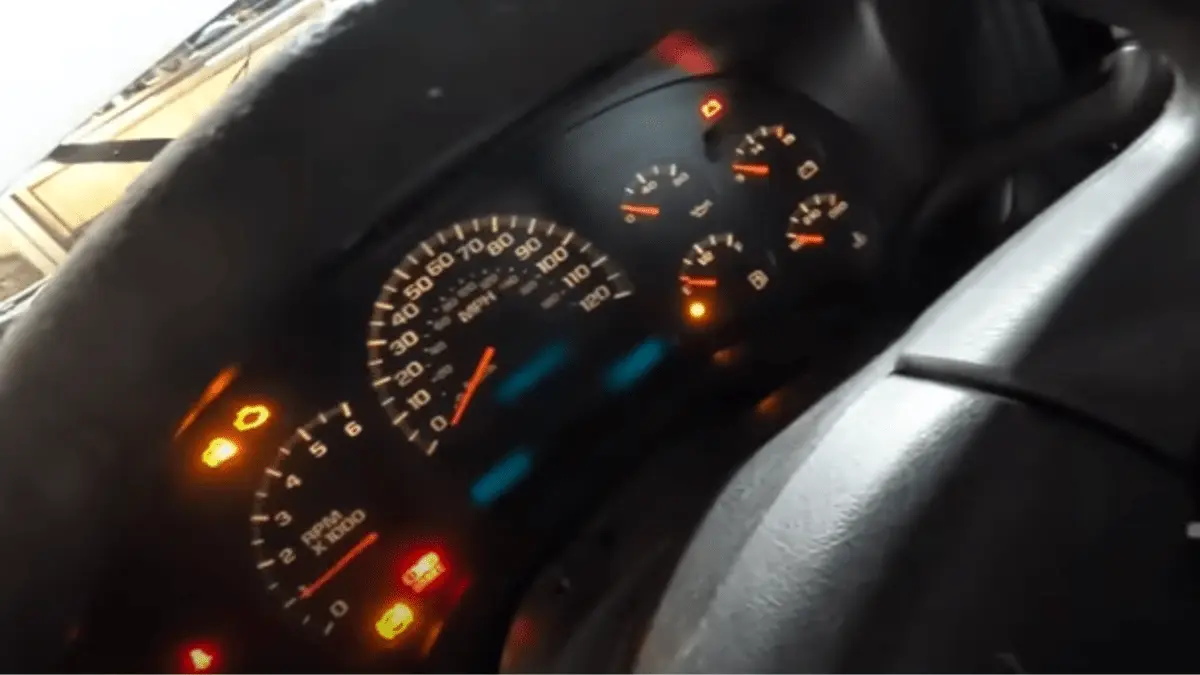The check engine light in your Chevy Silverado is like a vigilant sentinel, ready to warn you of potential issues with your vehicle’s performance. But why does the Chevy Silverado check engine light flashing then stops?
The Chevy Silverado’s check engine light may flash and stop for various reasons, including sensor malfunctions, clogged valves, or loose components. The intermittent flashing often indicates transient issues that require professional inspection and resolution to ensure the vehicle’s optimal performance and avoid potential damage.
If you’re a seasoned driver or a newbie, our blog post is your guide to understanding and resolving this peculiar issue.
RELATED: Chevy Silverado Check Engine Light Flashing When Accelerating
Meaning Of “Chevy Silverado Check Engine Light Flashing Then Stops”

A flashing Chevy Silverado check engine light, followed by its cessation, may indicate a malfunctioning mass airflow sensor (MAF). The MAF sensor is crucial in the fuel-air mixture and spark plug timing, communicating data to the engine control module (ECM). A faulty MAF sensor can disrupt this data flow, leading to an intermittent warning signal. It is crucial to address this issue promptly, as an erratic MAF sensor can impact engine performance, fuel efficiency, and emissions. Seeking professional diagnosis and potential sensor replacement is advised to maintain the vehicle’s optimal operation and minimize long-term damage.
Reasons For Chevy Silverado Check Engine Light Flashing Then Stops
1. Damaged Cable
A damaged cable can be one of the culprits behind your Chevy Silverado’s check engine light flashing and then stopping while driving. When a cable integral to the engine’s performance becomes compromised, it can lead to miscommunication between components. The quality of gasoline can exacerbate this issue, especially when blended with excessive ethanol content, surpassing legal limits.
Solution: To address this problem, a thorough inspection of the cable harness is necessary. Damaged cables should be repaired or replaced as needed. Additionally, using gasoline with lower ethanol content or additives to mitigate ethanol-related issues can prevent further cable damage. Proper maintenance and quality fuel choices can help avoid future occurrences.
2. Bad Catalytic Converter
The catalytic converter in your vehicle is a vital component responsible for reducing harmful emissions. Without it, your car would emit toxic gases like carbon monoxide into the environment. When the catalytic converter malfunctions, it can trigger the check engine light.
Solution: To rectify a bad catalytic converter, it must be repaired or replaced with a new one. This is a crucial step to ensure your vehicle meets emission standards and runs efficiently. However, the downside is the cost of replacing a catalytic converter, which can range from $2,000 or more. Regular maintenance and adhering to recommended driving practices can extend the life of your catalytic converter and avoid this costly issue.
3. EGR System Malfunction

A malfunction in the Exhaust Gas Recirculation (EGR) system can trigger the flashing check engine light in your Chevy Silverado. The EGR system plays a crucial role in reducing the emissions of harmful nitrogen oxides (NOx) by recirculating exhaust gas into the intake air. Over time, the EGR control valve or the associated pipeline can become clogged with dirt and soot, leading to performance issues and illuminating the check engine light.
Solution: To resolve this issue, it’s essential to have the EGR system inspected and cleaned or repaired as needed. Regular maintenance, such as cleaning the EGR components, can help prevent this problem. Suppose you need more clarification about the diagnosis or how to address it. In that case, it’s advisable to consult a reputable auto mechanic or dealer for a thorough inspection and appropriate repairs to ensure optimal engine performance and emissions control.
4. Oxygen Sensor Failure
The oxygen sensor in your vehicle plays a vital role in determining the right fuel-air mixture by measuring the oxygen concentration in the exhaust stream. This is crucial for engine efficiency and compliance with emission standards. When the oxygen sensor malfunctions, it can cause a significant increase in fuel consumption, sometimes up to 30%. The accurate data from a faulty oxygen sensor can lead to efficient combustion, resulting in higher fuel usage and the flashing check engine light.
Solution: When the check engine light blinks, it often indicates a problem with the oxygen sensor. Two common causes for inaccurate readings or sensor failure are contamination and wear. Replacing the oxygen sensor is typically the solution. Regular maintenance and the use of high-quality fuel can extend the life of the oxygen sensor and reduce the likelihood of such issues. Consulting a professional mechanic is advisable for accurate diagnosis and appropriate sensor replacement to improve fuel efficiency and reduce emissions. Addressing the issue promptly is essential to prevent further fuel wastage and engine inefficiency.
5. Air Filter Valve Blocked or Broken
A blocked or damaged air filter valve can lead to the flashing check engine light in your Chevy Silverado. This valve prevents gasoline vapor from escaping into the atmosphere, ensuring fuel efficiency and environmental safety. When blocked or broken, it can cause issues with vapor recapture and reintroduction to the combustion chamber.
Solution: If you suspect an issue with the air filter valve, it’s best to have a specialist mechanic inspect it to determine whether it’s damaged. If a problem is detected, replacing the valve may be necessary. This repair is relatively affordable and can help maintain fuel recapture and combustion efficiency, reducing fuel waste and emissions.
6. Loose or Open Gas Cap
Surprisingly, a loose or open gas cap can be a straightforward reason for the check engine light flashing and stopping. The gas cap is a vital component because it prevents gasoline vapors from escaping into the environment. When the gas tank cap is not tightly secured, it can lead to a drop in internal pressure, which can be detected by the sensor, triggering the check engine light.
Solution: If a loose or open gas cap causes the check engine light, the solution is simple. Ensure that the gas cap is securely fastened. Inspect the rubber seal on the cap for any damage, as a damaged seal can also lead to issues. If error codes indicate a faulty cap, it’s essential to verify the cap’s proper fit and condition. Replacing a damaged or ineffective gas cap is an inexpensive fix to resolve the issue and prevent fuel vapor leaks. Securing the gas cap is crucial to maintaining fuel efficiency and emission control.
7. Mass Air Flow Sensor Failure
A malfunctioning mass airflow (MAF) sensor can be a reason for your check engine light flashing and then stopping while driving. The MAF sensor plays a critical role by measuring the air entering the engine and relaying this information to the engine control module (ECM), which adjusts fuel and ignition timing accordingly. Over time, the MAF sensor can become susceptible to dust and grime, corrupting the data it sends and potentially compromising the entire system.
Solution: If your check engine light indicates a problem with the MAF sensor, it must be addressed promptly. The sensor may need cleaning or replacement to restore accurate airflow measurements and optimize engine performance. Regular maintenance and keeping the air filter clean can help prevent MAF sensor issues and maintain proper fuel-air mixture. Seeking professional diagnosis and potential sensor replacement is advised to ensure your engine operates efficiently.
8. Thermostat Malfunction
A malfunctioning thermostat valve can cause your check engine light to flash and then stop. The thermostat regulates the coolant flow to maintain the ideal engine cooling temperature, typically between 80 to 95 degrees Celsius. Prolonged use can lead to thermostat valve problems, including sticking. This can result in reduced cooling efficiency and potential engine overheating, prompting the check engine light to illuminate.
Solution: If the ECM detects a malfunctioning thermostat, it’s essential to address this issue promptly. Replacing the thermostat valve and ensuring proper coolant flow is crucial to prevent engine overheating and related damage. Regular cooling system maintenance, including checking the thermostat’s condition, can help avoid such problems and maintain engine temperature within the desired range.
9. Cracked Ignition Plugs
If your check engine light stops flashing, you may have an issue with your spark plugs. Problems with spark plugs, such as fouling, damaged connections, or broken high-voltage cables, can trigger the blinking check engine light. These issues can severely affect the combustion of the fuel-air mixture, leading to weak or mistimed sparks, resulting in reduced engine efficiency, increased vibration, jerky acceleration, starting difficulties, and potential stalling.
Solution: Addressing problems with spark plugs is crucial to restore engine performance. In the case of cracked or damaged spark plugs or related components, replacement is typically necessary. Regular maintenance, such as inspecting and replacing spark plugs as the manufacturer recommends, can help prevent these issues and ensure smooth engine operation. Consulting a professional mechanic for accurate diagnosis and timely repairs is advisable to avoid further engine complications.
The Warning Colors Of The Check Engine Light
The colors of the check engine light on your dashboard serve as vital signals, indicating the severity of the issue detected by your vehicle’s diagnostics:
Flashing Red Warning Light:
When the check engine light is flashing in red, it signifies imminent danger. You must immediately pull over and cease driving when you see this warning light. Ignoring it could lead to further damage to your vehicle. In such cases, you must contact your vehicle’s technical support team or a professional mechanic for a thorough investigation and prompt resolution.
Flashing Yellow Warning Light:
A flashing yellow check engine light serves as a cautionary signal. If your engine is running smoothly without unusual noises, black smoke, or strange odors emanating from the tailpipe, and if you haven’t noticed a significant increase in fuel consumption, you can breathe a bit easier. Start by checking visible components like the fuel cap, ensuring it’s properly sealed. If the yellow warning light persists on your dashboard, you should take your vehicle to a reputable auto shop for a thorough diagnostic check. This will help pinpoint the exact cause of the issue and ensure it is appropriately addressed to maintain your vehicle’s optimal performance and efficiency.
RELATED: Chevy Silverado Shuts Off While Driving And Won’t Start
FAQs
1. Can I continue driving if the check engine light flashes and then stops?
If the check engine light flashes, it’s generally recommended to pull over and have the issue assessed. Ignoring a flashing check engine light may lead to more significant damage to your vehicle.
2. Why does the check engine light in my Chevy Silverado flash on and off intermittently?
Intermittent flashing of the check engine light can occur for various reasons, such as sensor malfunctions or transient issues. It’s essential to have your vehicle inspected by a professional to identify the specific cause and address it accordingly.
3. How can I prevent my Chevy Silverado’s check engine light from flashing and stopping frequently?
Regular vehicle maintenance, including routine inspections, keeping up with recommended service schedules, and using high-quality fuel, can help prevent frequent occurrences of the check engine light flashing. Addressing issues promptly when they arise can also reduce the frequency of such incidents.
4. Is it safe to drive if the check engine light only flashes once and then stops?
If the check engine light flashes briefly and then goes off, it may not indicate a critical issue. However, it’s still recommended to have your vehicle checked by a mechanic to ensure there are no underlying problems. It is important to avoid driving without addressing potential issues to avoid more significant problems down the road.
5. Can I use an OBD-II scanner to diagnose the issue?
Yes, you can use an OBD-II scanner to retrieve diagnostic trouble codes (DTCs) when the check engine light flashes and stops. The scanner can help identify the specific issue that triggered the light. However, it’s important to remember that the scanner can provide information about the problem but may not sometimes offer a detailed solution.
Final Words
Understanding the root causes, whether a faulty sensor, a clogged valve, or a loose gas cap, empowers you to make informed decisions to maintain your vehicle’s performance. Regular maintenance, timely inspections, and quality fuel choices can be your allies in preventing these occurrences.
As you navigate the road ahead, remember that addressing these challenges promptly is key to keeping your Chevy Silverado in prime condition. Drive on confidently, knowing you have the knowledge and solutions to keep your trusted companion running smoothly.

Eric L. Friedman is a car expert who has worked on Chevy and GMC trucks for over 10 years. He started AutoYolo to help people fix their own cars. On the blog, he shares easy tips, step-by-step guides, and repair advice to make car problems less stressful and more affordable.

